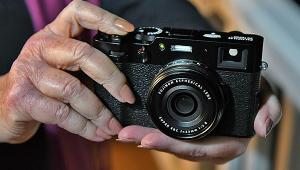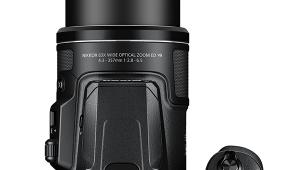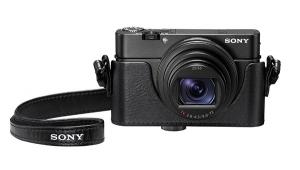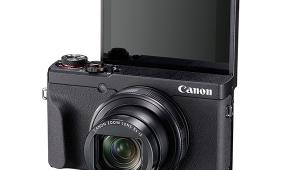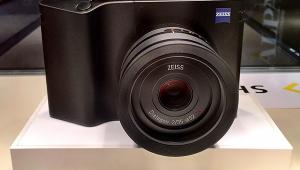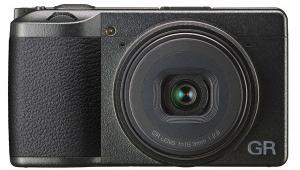The Goods: Here Are Our 4 Favorite Cameras of the Month

Little Stud
Canon proves that good things can come in small packages with the PowerShot G1 X Mark III camera. Canon stuffs a 24.2MP DSLR-size APS-C sensor inside the G1 X III’s compact camera body that’s about the size and weight of the svelte G5 X from 2015, which it resembles. The G1 X III’s CMOS imaging sensor is the same one that’s in the Canon EOS 80D DSLR and the Canon EOS M6 mirrorless camera. Canon’s previous “flagship” model in the G-series line, the G1 X Mark II has a larger and heavier camera body, and is fitted with a 1.5-inch sensor just a fraction of the size of an APS-C chip. The G1 X III has a 24-70mm equivalent lens with an aperture range of f/2.8-5.6 and Optical Image Stabilization (OIS), and while that’s shorter and a bit slower than the previous model’s lens, that’s how Canon has been able to make the big-chipped new camera so small and light. The new Canon G1 X III also adds faster Dual Pixel CMOS autofocus (AF) technology and a DIGIC 7 processor, and can shoot at approximately 7 frames per second (fps), or up to 9 fps with AF fixed. Other features include a drip-proof body; a three-inch vari-angle touchscreen LCD on back; Touch and Drag AF; 1080p HD movie shooting; and Wi-Fi, NFC, and Bluetooth capability.
Canon PowerShot G1 X Mark III
$1,299
usa.canon.com
 Long Ranger
Long Ranger
Looking for the ultimate all-in-one camera for capturing sports and wildlife? Sony may have created it with the RX10 IV, which has a massive built-in superzoom lens and a frame rate twice as fast as even some of the speediest professional DSLRs. The 20.1MP Sony RX10 IV features a 24-600mm f/2.4-4 zoom lens and can shoot at 24 frames per second continuously with full autofocus/autoexposure tracking. The RX10 IV also boasts what Sony is calling the “world’s fastest” autofocus speed and can shoot 4K video with full pixel readout without pixel binning. For a digital camera that can fit in the palm of your hand, those specs are impressive. Also new to the RX10 IV, which is the follow-up to the RX10 III from a few years ago, is a new hybrid autofocus (AF) system, which combines phase- and contrast-detection AF for faster focusing. (The previous camera’s contrast-detection AF was notoriously slow.) And while many superzoom cameras on the market use tiny imaging sensors, the RX10 IV has a one-inch type, 20.1MP Exmor RS CMOS stacked image sensor for crisper images. There’s also a three-inch tilting LCD screen on back with touch focus; a dust- and moisture-resistant camera body; and Wi-Fi, NFC, and Bluetooth.
Sony RX10 IV
$1,700
sony.com
 Faster Tracker
Faster Tracker
We like what Fujifilm has done with the rangefinder-style X-E3 mirrorless camera. One of the lower priced and most compact models in Fujifilm’s X-Series line, it’s like a junior version of the top-of-the-line X-Pro2. The X-E3 is even smaller and more lightweight than its predecessor, the X-E2, but adds Fujifilm’s latest 24.3MP X-Trans CMOS III image sensor; their X-Processor Pro high-speed image processing engine; and the ability to shoot 4K video. What might be most noteworthy about this retro-looking digital camera though is its revamped autofocus system, which offers faster autofocus tracking for moving subjects thanks, in part, to a larger phase-detection AF area. Fujifilm has also added a new image recognition algorithm to the X-E3, which the company says lets it track moving subjects half the size or moving twice as fast as previous models. The overall speed of the camera has increased, too: the start-up time is just 0.4 seconds; autofocus speed is a mere 0.06 seconds; and shutter lag is just 0.05 seconds.
Fujifilm X-E3
$899, body only; $1,149 with 23mm kit lens
fujifilmusa.com
 Entry Leveler
Entry Leveler
If you want to get your feet wet with mirrorless cameras, the Olympus OM-D E-M10 Mark III is a great place to start. This compact, retro-style shooter uses a 16MP Micro Four Thirds sensor and has built-in 5-Axis Image Stabilization offering four steps of correction for handshake. And while it is, technically, an entry-level camera with a relatively affordable price tag, it can shoot 4K video at 30p, which is a feature some higher-end competing models don’t offer. There’s also a three-inch touch panel, tilt screen on back; a faster TruePic VIII image processor inside; a 121-point autofocus system; 8.6 frames per second max burst shooting; and an auto ISO range of 100-6400. While none of these features are revolutionary, for a camera that sells for just a hair under $650, they’re surprisingly solid.
Olympus OM-D E-M10 Mark III
$649
getolympus.com
The Goods spotlights the hottest premium photo gear out there. If you have a product you’d like considered for The Goods, e-mail images and info to editorial@shutterbug.com.




